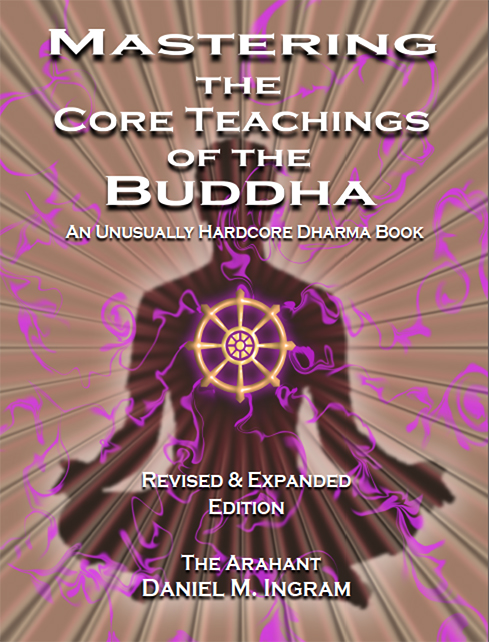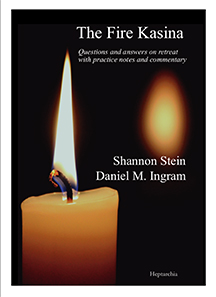The Cessation of Perception and Feeling (Nirodha Samapatti)
← The Concentration Models | Back to the Vajrayana Story →
Then there is an attainment called “the cessation of perception and feeling” (Pali: nirodha samapatti, henceforth NS, or simply nirodha in my general way of speaking) that is hard to classify. The word “nirodha” (meaning “cessation”) is also sometimes used without the qualifier “samapatti” to refer to Fruition, so be careful to keep your terms straight when reading the old texts or speaking with others about these subjects. I always mean the cessation of perception and feeling when I use the word “nirodha”, but others often do not and may mean Fruition.
This is the highest of the temporary attainments. It is discussed in multiple places, including sutta 44, “The Shorter Series of Questions and Answers”, from The Middle Length Discourses of the Buddha, in a talk given by a female arahant named Dhammadinna, and Path to Deliverance by Nyanatiloka, which draws from that fine text. You can also find it in commentaries, such as the Visuddhimagga, XXIII, 16, as well as in the last few pages of the Vimuttimagga. By the commentarial criteria at least, it can be attained only by anagamis and arahants who also have mastery of the formless jhanas. This attainment cannot be said to be either a state or not a state, nor can it be said to be strictly a concentration or an insight attainment, as it is attained by a fusion of both shamatha and vipassana and since it lacks a sensate basis for analysis, meaning there is no experience at all that can be analyzed, as perception and feeling have stopped.
We attain NS by fusing insight and concentration practices in a gentle way that is much less precise than if we wanted to attain Fruition, as well as much less concentration-heavy than we would use if we were doing pure jhana practice. I find it slightly easier to attain NS when reclining, but the first time I attained it I was sitting. We rise through the shamatha jhanas in a low-key way with some light awareness of their true nature (the three characteristics), and then enter the eighth jhana (Neither Perception Nor Non-Perception), and then emerge from that state to that magical post-eighth junction point from which we might also attain the pure abodes. Technically, in the old texts we find that there are a few other points of set-up that we might do before this, including to make sure that we are not going to die before the state ends, resolving to wake up if summoned by the sangha, and some other minor details, but I have not found them necessary.
Sometime shortly thereafter, and without warning or a very recent premeditation, we may suddenly enter the cessation of perception and feeling, or we might not, depending on whether we have met the entrance criteria and are not inclining to anything else. Please note that previous interest in attaining this during the preceding days or weeks tends to increase the chances of this attainment occurring, as do resolutions just before starting the ascent from the first through the eighth jhanas. As we get better at attaining this, we can slip in the inclination (resolution, intention) to attain it after emerging from the eighth jhana and then forget about it before dropping in. There is really nothing that can be said about this attainment, except for things that relate to entering, exiting, and the consequences of the attainment, all of which are unique to nirodha.
The texts rightly say that, upon entering nirodha, verbal formations cease first, then physical sensations, then the whole of mental functioning ceases when the attainment is fully entered. This is traditionally explained as correlating to the first jhana, the fourth jhana, and then the entrance into nirodha, respectively. However, you may notice that in the three moments before cessation of perception sets in (during the complete power failure–like entrance) verbal formations, bodily formations, and mental formations cease in that order also in three consecutive and distinct moments, with the whole entrance taking about one-third of a second, like someone threw the master dimmer/power switch on sensate reality all the way down and the whole thing just shut off. The texts may have a double meaning, or may have been misinterpreted by scholars who had never themselves attained nirodha samapatti. I say this because it is still typical for bodily and verbal formations to arise between the eighth jhana and the entrance to NS, and thus the traditional interpretation does not hold up in experience.
The texts also say that this attainment may last seven days or even longer (some say up to ten days), but I don’t personally know of anyone who has admitted to this occurring in their experience. That doesn’t mean it can’t happen, but it would probably require a long and sustained retreat beforehand to generate the necessary stability and stillness of mind. The duration of such attainments will be related directly to our concentration abilities, and these are very dependent upon practice conditions and how much concentration abilities have recently been exercised.
Please also note that, like Fruition, there is no experience at all during NS. There is no time, no space, no something, no nothing, not anything at all. Just as a desktop computer shuts down totally when you press the power button, so too with anything to do with experience in NS. I have friends who have talked about something they got into where they could still feel time passing, and that is definitely not it. NS is like the ultimate rest for the mind, something far beyond even deep sleep, as even a few seconds in it leaves one with a massive feeling of having gone extremely deep in a way nothing else can match.
Unlike Fruition, we exit this attainment in the reverse way we came in, with mental formations arising first, quickly followed by physical and then verbal formations in the characteristic analogue way of the entrance and with the same timing, like throwing on a big dimmer switch in about one-third of a second. After leaving this attainment, the mind tends to be a remarkable mixture of deeply peaceful while very clear, and our body tends to be very relaxed. The longer the attainment lasted, the stronger and longer-lingering this effect will be.
I have found it to be by far the most impressive, long-lasting, and heavy of the afterglows of the various attainments, and have noted feeling the effects of it for up to about twenty-four hours afterwards. From my point of view, the whole point of attaining to NS (other than learning the level of control needed to attain to it, which has it own rewards for other avenues of spiritual development—and for just showing off and proving you can do it—is the amazing afterglow. Thus, I would not recommend attaining this immediately before entering into situations that require quick decisions or actions, such as driving in complex traffic. The texts say that we incline to solitude or quiet after attaining this state, and in general I agree. Loud noises and jarring situations can be particularly so after NS. Its afterglow is very conducive to deep relaxation, deep practice, deep insight, and deep magickal workings—that is if you can get up the emotional energy to care at all about those workings in the face of that stunningly chill afterglow. I talk about the powers later so, if the topic of magick bothers you, just pretend I didn’t write that. Say, “La, la, la, la, la …” in your head to clear the memory of it, or whatever.
While I am nervous about the current trend to use meditation to create more productive, compliant, and docile worker-bees, I must admit that studying for my emergency medicine board exam one day in the afterglow of NS was like a dream come true. I could steadily plow through hundreds of pages for hours and hours with vastly less mental fatigue than I would have had in any other state I am familiar with.
Aside from nirodha samapatti’s importance due to being included in some system’s criteria for various stages of awakening, it is worth mentioning this attainment because it is found today by real, living practitioners but has often been relegated to the realm of myth and legend or has been ignored or even forgotten entirely. It is not that nirodha samapatti is necessary, but it is a good and useful thing to be able to attain. In fact, I have not yet spoken with anyone who had attained it who didn’t consider it the absolute King Daddy of meditation attainments other than arahantship, as the depth of its afterglow never fails to impress and amaze. Hopefully, mentioning it will raise the standard to which people feel they can reasonably aspire, which is basically the whole goal of this book.
One more little morsel for you brave adventurers … I have noticed that the easiest time to attain NS is usually a few weeks after attaining a path, when the vipassana jhana aspect of the progress of insight is becoming clear and a nice degree of mastery has been attained in that Review phase. However, it has this nice/nasty habit of helping to precipitate a new progress cycle, as the level of clarity gained in its wake is impressive, and clarity furthers insight. Thus, we may go from the best highs of a Review phase and NS’s glorious afterglow to the third ñana, A&P, and the Dark Night quickly. In fact, this seems to be a very natural part of many cycles of anagamis who also know the eight jhanas and how to ride the line between concentration and insight practices. One word of warning: NS’s afterglow is so extreme that it is easy to imagine that one has attained some new level of awakening, as the mind feels very, very different after NS has occurred, and residual hindrances and negative mind states may be very far away. Wait at least a few days after any dive into NS to see how those changes hold up in the face of the world before starting to draw any conclusions.
I must say, there is something truly fairy-tale wonderful about NS. That you can pick up a book from about 2,000 years ago that gives complex instructions like some weird recipe for something you can do with your brain that you would have otherwise been extremely unlikely to know as even being possible, and that you can follow those instructions and they can actually work, blew my doors off the first time I did it. This stuff is just amazing! Yay, dharma!

